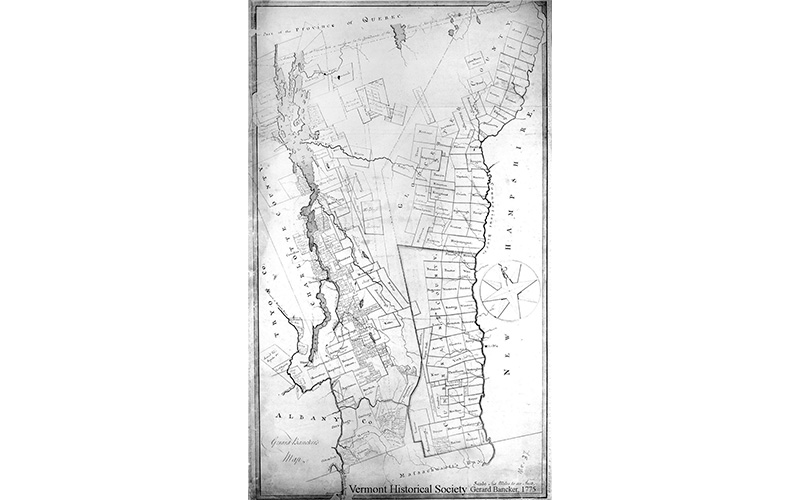Here are my excuses for not knowing the history of Vermont: I grew up in New Jersey and history was my worst subject in school. Thank the Lord, the Vermont Historical Society has a terrific website because I needed their help. In my last article, thanks to the Waitsfield Historical Society, we discovered that the bicentennial of the settlement of Waitsfield came before the bicentennial of the establishment of Vermont as the 14th state of the United States of America. I wanted to figure out how this could be so.
First, let’s refresh our memories about the Revolutionary War. It was fought by the 13 American colonies from 1775 to 1783 against Great Britain which established and owned them. Vermont was not one of those colonies. Facts like this don’t stick in my brain unless I make them personal. Our family’s ancestor,14-year-old Jonathan Mehuron of Massachusetts, was called into service to fight against the English in 1776. You weren’t supposed to be drafted until you were 16, but an exception was made because his father, David Mehuron, couldn’t fight and sent Jonathan in his stead. In 1779 Jonathan left the service and moved to our neck of the woods. The part that would eventually become Vermont.
But at that time the state of New York believed it owned current-day Vermont. King George of England, who thought he was in charge of all the colonies, agreed that the New York border should go all the way to the border of New Hampshire. From The Vermont Historical Society: “In 1764, King George III... said that the Connecticut River was the border between New York and New Hampshire. ‘His Majesty doth order and declare the western banks of the River Connecticut, from where it enters the Province of the Massachusetts Bay, as far north as the forty-fifth degree of northern latitude, to be the boundary line between the said two Provinces of New Hampshire and New York.’
“Lieutenant Governor Cadwallader Colden [Of New York. He lived in Queens] began selling land to groups of settlers to start towns. The people who had patents from New York were called Yorkers. Colden knew that some of this land was part of the New Hampshire grants. He knew that some settlers had already started farms. But he also knew that the land belonged to New York.
“Settlers who had a New Hampshire Grant could pay money to New York to keep their grant. Some settlers did not want to pay more money. New York began selling this land to new owners. This led to disagreements between the New Hampshire grants and the Yorkers.”
Okay, but our Jonathan Mehuron was already here trying to settle in Vermont and create a living for himself. What did immigrants like him do? “Ethan Allen owned land in the New Hampshire grants. He did not want to lose his land to the Yorkers. He also did not want to pay more money for his land. Other settlers felt the same way. After talking at the Catamount Tavern in Bennington, these men joined together to start the Green Mountain Boys.”
It has suddenly become clear to me that ownership is a matter of perspective. King George wanted to control our Green Mountains; New Yorkers claimed it but were also selling tracks of land and New Hampshire fought for our lush valleys too. Not all of the settlers supported the Green Mountain Boys. Some descriptions depict them as a bunch of hooligans breaking the law and threatening Yorkers. Some threw up their hands and paid money to New York to keep their land.
We know from the last article that General Wait was a big shot among the Green Mountain Boys and that they protected Vermont during the Revolutionary War.
“It was not a certainty... that Vermont would become the fourteenth state in the Union. America was still at war and victory wasn’t assured. New York, an important part of the American effort, wasn’t going to give up title to the Grants without a fight. Vermont didn’t improve its chances of acceptance when it began negotiating with Great Britain to become part of greater Canada. The American Congress was suspicious of the new republic and became even more frustrated when Vermont tried to annex more lands—this time from New Hampshire.”
Now does that blow your mind? That we might well be part of Canada right now?
“Negotiations continued through the 1780s. Finally, in 1790 New York and Vermont settled their long-standing differences over the grants. In January 1791 Vermont delegates met in Bennington and ratified the U.S. Constitution. On March 4, 1791, Vermont was accepted into the United States of America, as the fourteenth state.”
We are now full circle back to the walking tour flier created by the Waitsfield Historical Society declaring the Bicentennial of the State of Vermont to be 1791 to 1991. And the Snapshots: Waitsfield, Vermont booklet celebrating the Bicentennial of the settlement of our town by General Wait and his family to be 1789 to 1989. Another mystery solved.
Mary Kathleen Mehuron, lives in Waitsfield and writes novels. Contact her at













